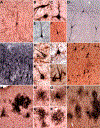Aged chimpanzees exhibit pathologic hallmarks of Alzheimer's disease
- PMID: 28888720
- PMCID: PMC6343147
- DOI: 10.1016/j.neurobiolaging.2017.07.006
Aged chimpanzees exhibit pathologic hallmarks of Alzheimer's disease
Abstract
Alzheimer's disease (AD) is a uniquely human brain disorder characterized by the accumulation of amyloid-beta protein (Aβ) into extracellular plaques, neurofibrillary tangles (NFT) made from intracellular, abnormally phosphorylated tau, and selective neuronal loss. We analyzed a large group of aged chimpanzees (n = 20, age 37-62 years) for evidence of Aβ and tau lesions in brain regions affected by AD in humans. Aβ was observed in plaques and blood vessels, and tau lesions were found in the form of pretangles, NFT, and tau-immunoreactive neuritic clusters. Aβ deposition was higher in vessels than in plaques and correlated with increases in tau lesions, suggesting that amyloid build-up in the brain's microvasculature precedes plaque formation in chimpanzees. Age was correlated to greater volumes of Aβ plaques and vessels. Tangle pathology was observed in individuals that exhibited plaques and moderate or severe cerebral amyloid angiopathy, a condition in which amyloid accumulates in the brain's vasculature. Amyloid and tau pathology in aged chimpanzees suggests these AD lesions are not specific to the human brain.
Keywords: Alzheimer's disease; Amyloid-beta protein; Chimpanzee; Neurofibrillary tangle; Primate; Tau.
Copyright © 2017 Elsevier Inc. All rights reserved.
Figures







References
-
- Akram A, Christoffel D, Rocher AB, Bouras C, Kovari E, Perl DP, Morrison JH, Herrmann FR, Haroutunian V, Giannakopoulos P, Hof PR, 2008. Stereologic estimates of total spinophilinimmunoreactive spine number in area 9 and the CA1 field: relationship with the progression of Alzheimer’s disease. Neurobiol. Aging 29, 1296–1307. doi:10.1016/j.neurobiolaging.2007.03.007 - DOI - PMC - PubMed
-
- Arriagada PV, Marzloff K, Hyman BT, 1992. Distribution of Alzheimer-type pathologic changes in nondemented elderly individuals matches the pattern in Alzheimer’s disease. Neurology 42, 1681–1688. - PubMed
-
- Bachevalier J, Landis LS, Walker LC, Brickson M, Mishkin M, Price DL, Cork LC, 1991. Aged monkeys exhibit behavioral deficits indicative of widespread cerebral dysfunction. Neurobiol. Aging 12, 99–111. - PubMed
Publication types
MeSH terms
Substances
Grants and funding
LinkOut - more resources
Full Text Sources
Other Literature Sources
Medical

